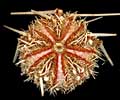The Echinoid Directory
Contributed by Simon Coppard, October 2006
Coelopleurus (Keraiophorus) longicollis A. Agassiz & H. L. Clark, 1908, p. 89
| Diagnostic Features |
|
|---|---|
| Distribution | Recent, Philippines |
| Classification and/or Status | Arbacioida, Arbaciidae, Coelopleurus. |
| Remarks | This species is similar to C. (K.) granulatus in the markings on the interambulacra, however, its is easily distinguished by its flattened test aborally, by the predominantly cream colour of the primary spines, and by the very short distal regions of the ophicephalous pedicellariae. Agassiz, A. & Clark, H. L. 1908. Hawaiian and other Pacific Echini; The Saleniidae, Arbaciidae, Aspidodiadematidae, and Diadematidae. Memoirs of the Museum of Comparative Zoology, Harvard University 34, 43-134, pls 45-59. |



